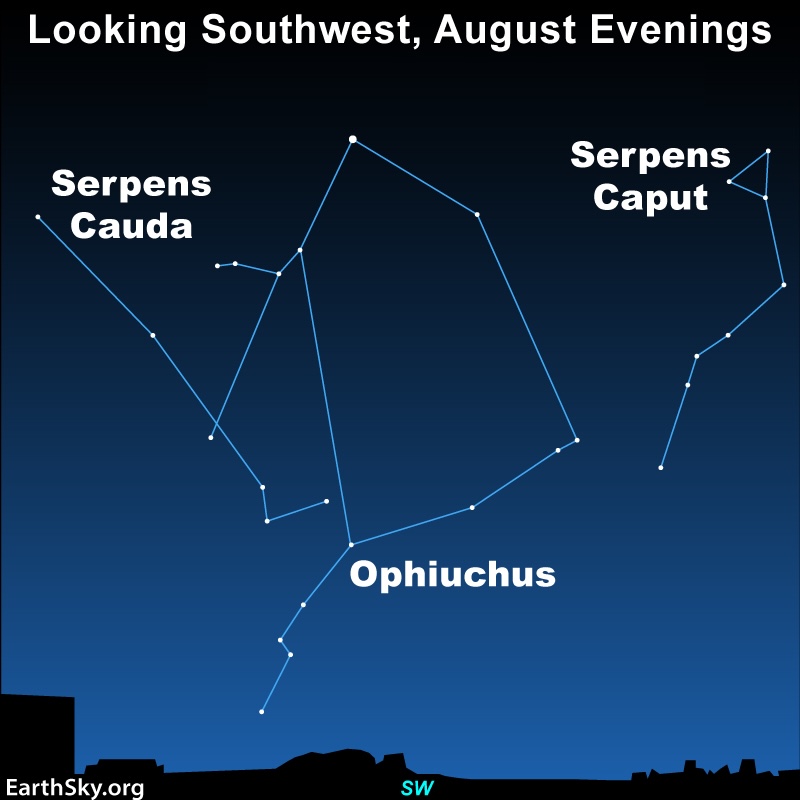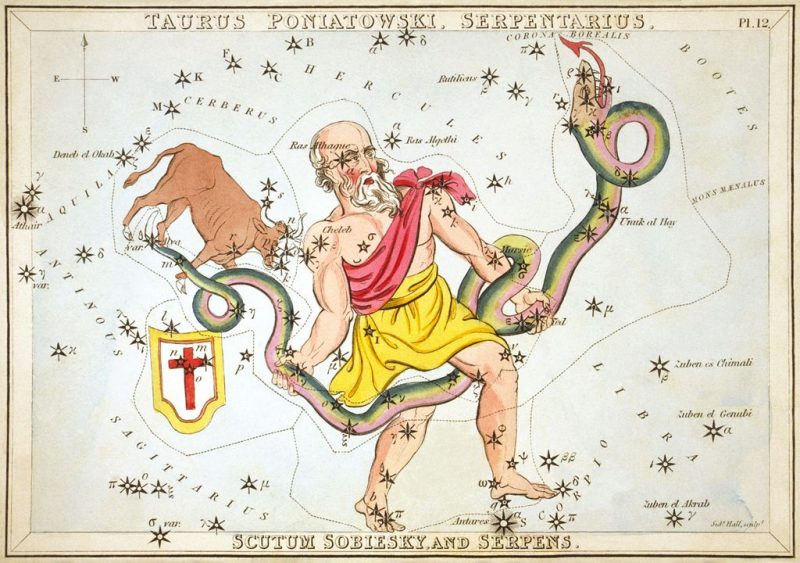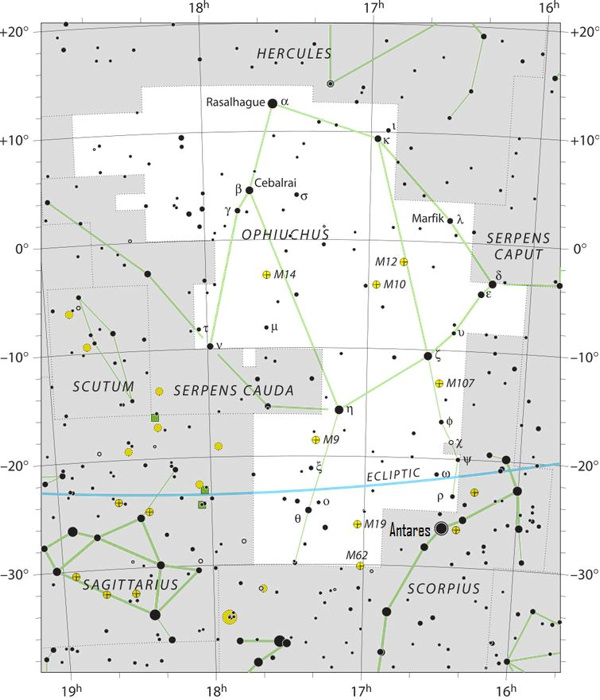
Ophiuchus, the unofficial 13th constellation of the zodiac
If you were born somewhere between November 30 and December 18, chances are the sun was in the constellation Ophiuchus the Serpent Bearer. Therefore, your “sign” should be Ophiuchus. But, of course, Ophiuchus is not an official constellation of the zodiac, nor will you find it in horoscopes. Ophiuchus the Serpent Bearer is a large constellation that you can spot near the southern horizon from the Northern Hemisphere during July, August and September evenings. The Serpent Bearer is standing on the Scorpion and its red star Antares.
From the Southern Hemisphere, Ophiuchus is closer to overhead. Ophiuchus’ brightest star is Rasalhague.
The official boundary lines for all 88 constellations were drawn up by the International Astronomical Union (IAU) in the 1930s.
Signs versus constellations
Poor Ophiuchus. Nobody ever claims him as a birth sign, despite the fact that the ecliptic runs across him, too. After all, the band of the zodiac extends some 8 degrees north and south of the ecliptic, spanning a total of 16 degrees in width. And the constellations are not evenly spaced along this band in our sky. The signs of the zodiac are familiar to all who read online astrology advice. There are 12 familiar signs of the zodiac, but no Ophiuchus.
Yet the moon and planets do regularly move within the boundaries of Ophiuchus. And so does the sun. The sun is in front of Ophiuchus from about November 30 to December 18 each year.
The sun is said to enter the sign Sagittarius around November 21, or whenever the sun is precisely 30 degrees west of the December solstice point. And then the sun then enters the sign Capricorn on the December 21 solstice. So the sun passes through the “sign” Sagittarius for the period before and up to the December solstice, irrespective of the fact that the sun is actually shining in front of the constellation Ophiuchus from November 30 to December 18.
By the way, the December solstice point moves one degree westward in front of the zodiacal constellations – or backdrop stars – in about 72 years. This means that the December solstice point will finally move into the constellation Ophiuchus by the year 2269.

When and where to locate Ophiuchus
The best time to observe Ophiuchus is during a Northern Hemisphere summer (Southern Hemisphere winter). From the Northern Hemisphere, late July and early August present this constellation high in the southern sky at nightfall and early evening. It’s in the southwest sky on autumn evenings in the Northern Hemisphere.
This rather large constellation fills the area of sky to the north of the constellation Scorpius the Scorpion and to the south of the constellation Hercules the Strongman. If you’re familiar with Scorpius’ brightest star Antares, try star-hopping to Ophiuchus from this ruddy gem of a star. The head of Ophiuchus is marked by the star Rasalhague (Alpha Ophiuchi).

Ophiuchus is joined in legend and in the sky to the constellation of the Serpent. If you have a dark sky, you might find this is one constellation that looks like what it’s supposed to be: a big guy holding a snake. The name Ophiuchus comes from two Greek words meaning serpent and holding.
Deep-sky objects in Ophiuchus
On a night when the moon is absent, take your binoculars and use them to scan Ophiuchus, which lies near the band of the Milky Way and so has many deep-sky wonders. Ophiuchus boasts of numerous globular clusters, for example. The two easiest globular clusters to see with ordinary binoculars are M10 and M12, as shown on the above chart. Through binoculars, they look like faint puffs of light, but with the telescope, you begin to see these globular clusters for what they really are. They are immense stellar cities spanning a hundred to a few hundred light-years in diameter, teeming with hundreds of thousands of stars.
Another big deep-sky favorite is the Pipe Nebula, a vast interstellar cloud of gas and dust sweeping across about 7 degrees of sky. At arm’s length, that’s about the width of three to four fingers. This dark nebula resides at a distance of 600 to 700 light-years in southern Ophiuchus. You can see it with the unaided eye in a dark, transparent sky. The Pipe Nebula is due east of the star Antares and due north of the stars Shaula and Lesath. These two stars (but not the Pipe Nebula) are shown on the above chart.
Ophiuchus in myth and star lore
In Greek sky lore, Ophiuchus represents Asclepius, Greek god of medicine and doctors. He is always holding a great serpent or snake. And, depending on how it’s used, a snake’s venom can either kill or cure. It’s said that Asclepius concocted a healing potion from the venom of Serpens the Serpent, mixing it with a Gorgon’s blood and an unknown herb. This potion gave humans access to immortality, until the god of the underworld, Pluto, appealed to the king of the gods. Pluto asked Zeus to reconsider the ramifications of the death of death.
We hardly know how Pluto made his appeal. Perhaps he said only that which never lives never dies, and that no mortal can have one without the other. Sophocles may have expressed the myth’s inherent message when saying:
Better to die, and sleep the never-waking sleep, than linger on and dare to live when the soul’s life is gone.
Possibly, the poet T.S. Eliot echoed the theme of the ever-living story in his Four Quartets:
We die with the dying:
See, they depart, and we go with them.
We are born with the dead:
See, they return, and bring us with them.
In any event, according to the myth, Zeus confiscated the potion, removed Asclepius from Earth and placed the gifted physician into the starry heavens. Today, the Staff of Asclepius – symbol of the World Health Organization and other medical organizations – pays tribute to this story and echoes the mighty celestial shape of the constellation Ophiuchus the Serpent Bearer.
Ophiuchus in history and science
It’s been more than 400 years since anyone has seen a supernova explosion of a star within our own Milky Way galaxy. But in the year 1604, a supernova known as Kepler’s Supernova exploded onto the scene, attaining unaided-eye visibility for 18 months. It shone in southern Ophiuchus, not all that far from the Pipe Nebula.
Kepler’s Supernova in 1604 came upon the heels of Tycho’s Supernova that lit up Cassiopeia in 1572. These supernovae sent shock waves into the intelligentsia of Europe, which firmly believed in the Aristotelian notion of an immutable universe outside the orbit of the moon. Tycho Brahe took a parallax measurement of the 1572 supernova, proving that it could not be an atmospheric phenomenon. In fact, the supernova shone well beyond the moon’s orbit. Shortly thereafter, Kepler’s Supernova in 1604 seemed to drive home the point all over again.
Moreover, Tycho Brahe measured the distance of a comet in 1577, also finding it to be farther away than the moon. Aristotelians wanted to believe comets were gases burning in the atmosphere, but once again, Tycho threw cold water on the idea of Aristotle’s immutable universe.
Bottom line: The sun lies within the boundaries of the constellation Ophiuchus the Serpent Bearer for about two weeks of every year. Thus, Ophiuchus is an unofficial member of the zodiac. Learn the difference between constellations and signs, and how to locate Ophiuchus.
The constellations of the zodiac
Say hello to Aries the Ram
Meet Taurus the Bull in the evening sky
Meet Gemini the Twins, home to 2 bright stars
Cancer the Crab and its Beehive Cluster
Leo the Lion and its backward question mark
Virgo the Maiden in northern spring skies
Meet Libra the Scales, a zodiacal constellation
Scorpius the Scorpion is a summertime delight
Sagittarius the Archer and its famous Teapot
Capricornus the Sea-goat has an arrowhead shape
Meet Aquarius the Water Bearer and its stars
Meet Pisces the Fish, 1st constellation of the zodiac
Enjoying EarthSky? Sign up for our free daily newsletter today!











